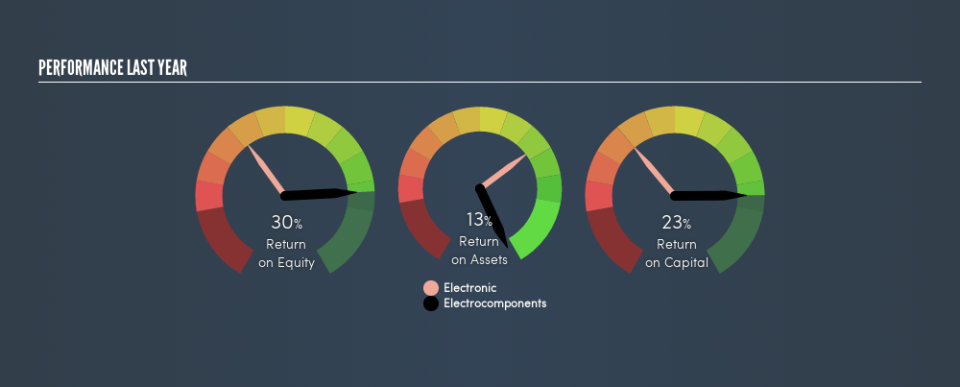Are Electrocomponents plc’s (LON:ECM) High Returns Really That Great?

Today we'll look at Electrocomponents plc (LON:ECM) and reflect on its potential as an investment. In particular, we'll consider its Return On Capital Employed (ROCE), as that can give us insight into how profitably the company is able to employ capital in its business.
Firstly, we'll go over how we calculate ROCE. Second, we'll look at its ROCE compared to similar companies. And finally, we'll look at how its current liabilities are impacting its ROCE.
What is Return On Capital Employed (ROCE)?
ROCE measures the 'return' (pre-tax profit) a company generates from capital employed in its business. In general, businesses with a higher ROCE are usually better quality. In brief, it is a useful tool, but it is not without drawbacks. Renowned investment researcher Michael Mauboussin has suggested that a high ROCE can indicate that 'one dollar invested in the company generates value of more than one dollar'.
So, How Do We Calculate ROCE?
Analysts use this formula to calculate return on capital employed:
Return on Capital Employed = Earnings Before Interest and Tax (EBIT) ÷ (Total Assets - Current Liabilities)
Or for Electrocomponents:
0.23 = UK£196m ÷ (UK£1.4b - UK£492m) (Based on the trailing twelve months to September 2018.)
So, Electrocomponents has an ROCE of 23%.
Check out our latest analysis for Electrocomponents
Is Electrocomponents's ROCE Good?
ROCE can be useful when making comparisons, such as between similar companies. Electrocomponents's ROCE appears to be substantially greater than the 14% average in the Electronic industry. We would consider this a positive, as it suggests it is using capital more effectively than other similar companies. Putting aside its position relative to its industry for now, in absolute terms, Electrocomponents's ROCE is currently very good.
In our analysis, Electrocomponents's ROCE appears to be 23%, compared to 3 years ago, when its ROCE was 7.2%. This makes us think about whether the company has been reinvesting shrewdly.
Remember that this metric is backwards looking - it shows what has happened in the past, and does not accurately predict the future. Companies in cyclical industries can be difficult to understand using ROCE, as returns typically look high during boom times, and low during busts. This is because ROCE only looks at one year, instead of considering returns across a whole cycle. What happens in the future is pretty important for investors, so we have prepared a free report on analyst forecasts for Electrocomponents.
What Are Current Liabilities, And How Do They Affect Electrocomponents's ROCE?
Current liabilities are short term bills and invoices that need to be paid in 12 months or less. Due to the way ROCE is calculated, a high level of current liabilities makes a company look as though it has less capital employed, and thus can (sometimes unfairly) boost the ROCE. To counter this, investors can check if a company has high current liabilities relative to total assets.
Electrocomponents has total assets of UK£1.4b and current liabilities of UK£492m. Therefore its current liabilities are equivalent to approximately 36% of its total assets. Electrocomponents's ROCE is boosted somewhat by its middling amount of current liabilities.
The Bottom Line On Electrocomponents's ROCE
Even so, it has a great ROCE, and could be an attractive prospect for further research. There might be better investments than Electrocomponents out there, but you will have to work hard to find them . These promising businesses with rapidly growing earnings might be right up your alley.
If you like to buy stocks alongside management, then you might just love this free list of companies. (Hint: insiders have been buying them).
We aim to bring you long-term focused research analysis driven by fundamental data. Note that our analysis may not factor in the latest price-sensitive company announcements or qualitative material.
If you spot an error that warrants correction, please contact the editor at editorial-team@simplywallst.com. This article by Simply Wall St is general in nature. It does not constitute a recommendation to buy or sell any stock, and does not take account of your objectives, or your financial situation. Simply Wall St has no position in the stocks mentioned. Thank you for reading.

 Yahoo Finance
Yahoo Finance 
